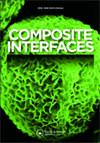baf2o4 /MWCNTs/环氧纳米复合材料的铁电、介电和电磁干扰衰减特性
IF 2.4
4区 材料科学
Q3 MATERIALS SCIENCE, COMPOSITES
引用次数: 0
摘要
摘要采用共沉淀法合成了钡铁氧体(BaFe2O4)颗粒,并将其用于制备BaFe2O4/多壁碳纳米管(MWCNTs)/环氧纳米复合材料。此外,还研究了材料的结构性能、铁电性能、介电性能和电磁衰减性能。研究了不同浓度的BaFe2O4、频率和温度对介电性能的影响。在外加电场作用下,随着BaFe2O4浓度的增加,介质介电常数随着界面极化而增大。介电常数在低频时最高,随频率的增加而减小。随着温度的升高,介电常数先增大后减小,这是由于界面上电荷的积累,并导致界面极化,铁电行为证实了这一点。其中,BaFe2O4/MWCNTs/环氧复合材料(BFO为40 phr, phr为百份/百份)的饱和极化值(PS)最高,为0.31µC/cm2,剩余极化值(Pr)最低,为~0.009µC/cm2。此外,在11.3 GHz频率下,当BaFe2O4浓度为40 phr时,复合材料的电磁干扰屏蔽效能(SE)接近19 dB。其中,以反射为主的SE为~1.06 dB,以吸收为主的SE约为18.67 dB,占总SE的主导地位。本文进一步阐述了BaFe2O4/MWCNTs/环氧纳米复合材料在电磁干扰屏蔽中的吸收优势行为。关键词:聚合物复合材料;铁氧体;介电介质;制备的纳米复合材料具有铁电性。温度增加了纳米复合材料的介电性能。40倍率BaFe2O4的纳米复合材料对电磁干扰的屏蔽效果接近19 dB。与反射相比,BaFe2O4/MWCNTs/环氧纳米复合材料具有更好的吸收主导的电磁干扰屏蔽效果。我们非常感谢印度科学与工业研究理事会(CSIR)对研究奖学金CSIR- srf(文件号:CSIR- srf)的支持。- 09/1244(0003)/2019-EMR-1)和st - purse补助金给斋浦尔拉贾斯坦邦和睦大学,用于提供必要的设施。披露声明作者未报告潜在的利益冲突。概念化,方法论,材料准备,数据收集,调查,形式分析,写作-原稿,可视化:Shivali Meena;数据收集,调查,形式分析,写作-可视化,审查和编辑:Neelam Kumari;表征-矢量网络分析仪:Vishant Gahlaut;表征- P-E回路:Chander Shekhar;表征- x射线衍射仪,扫描电子显微镜,监督:Supratim Mitra;验证,资源,可视化,监督,写作-审查和编辑:Umesh Kumar Dwivedi。数据可用性声明支持本研究结果的数据可根据通讯作者的要求提供。由于隐私或道德限制,这些数据不会公开。患者同意声明作者同意参与本研究。印度科学与工业研究基金理事会(CSIR),拨款09/1244(0003)/2019-EMR-1。本文章由计算机程序翻译,如有差异,请以英文原文为准。
Ferroelectric, dielectric, and EMI attenuation characteristics of BaFe 2 O 4 /MWCNTs/epoxy nanocomposites
ABSTRACTThis study reports the synthesis of barium-ferrite (BaFe2O4) particles by co-precipitation method, which is employed to prepare BaFe2O4/multiwall carbon nanotubes (MWCNTs)/epoxy nanocomposites. Furthermore, the structural properties, ferroelectric and dielectric properties, and electromagnetic attenuation properties are studied. The role of varying concentrations of BaFe2O4, frequency, and temperature on dielectric behavior is studied. In the presence of applied field, dielectric constant enhances as a result of interfacial polarization with increasing BaFe2O4 concentration. The permittivity is highest at low frequency and decreased with increasing frequency. With temperature, initially, dielectric constant increases and then decreases as a result of charge accumulation at interfaces and leads to interfacial polarization as confirmed by ferroelectric behavior. Here, BaFe2O4/MWCNTs/epoxy composite (with 40 phr BFO, where phr denotes parts per hundred) exhibited the highest value of saturation polarization (PS) ~0.31 µC/cm2 and low value of remanent polarization (Pr), that is ~0.009 µC/cm2. Moreover, composites exhibited high electromagnetic interference (EMI) shielding effectiveness (SE) of nearly 19 dB for 40 phr BaFe2O4 concentration at 11.3 GHz. Here, the reflection-dominated SE is ~1.06 dB and absorption-dominated SE is about 18.67 dB, which dominates the total SE. The absorption-dominant behavior is depicted by the BaFe2O4/MWCNTs/epoxy nanocomposites in EMI shielding as further conferred in the text.KEYWORDS: Polymer compositeferriteinterfacedielectricEMI shielding Highlights BaFe2O4/multiwall carbon nanotubes (MWCNTs)/epoxy nanocomposites are prepared.The prepared nanocomposites are ferroelectric.Temperature increases dielectric properties of the nanocomposites.Nanocomposite with 40 phr BaFe2O4 shows nearly 19 dB electromagnetic interference (EMI) shielding.BaFe2O4/MWCNTs/epoxy nanocomposites show more absorption-dominated EMI shielding compared to reflection.AcknowledgementsWe greatly acknowledge the Council of Scientific and Industrial Research (CSIR), India, for supporting the Research Fellowship CSIR-SRF (File no. – 09/1244(0003)/2019-EMR-1) and DST-PURSE Grant to Amity University Rajasthan, Jaipur for providing necessary facilities.Disclosure statementNo potential conflict of interest was reported by the authors.Author contributionsConceptualization, methodology, material preparation, data collection, investigation, formal analysis, writing – original draft, visualization: Shivali Meena; Data collection, investigation, formal analysis, writing – visualization, review and editing: Neelam Kumari; Characterization – Vector Network Analyzer : Vishant Gahlaut; Characterization – P-E loop : Chander Shekhar; Characterization – X-ray diffractometer, scanning electron microscopy, supervision: Supratim Mitra; Validation, resources, visualization, supervision, writing – review and editing : Umesh Kumar Dwivedi.Data availability statementThe data that support the findings of this study are available on request from the corresponding author. The data are not publicly available due to privacy or ethical restrictions.Statement of patient consentThe author’s consent to participate in this study article.Additional informationFundingCouncil of Scientific and Industrial Research (CSIR), India, Grant 09/1244(0003)/2019-EMR-1.
求助全文
通过发布文献求助,成功后即可免费获取论文全文。
去求助
来源期刊

Composite Interfaces
工程技术-材料科学:复合
CiteScore
5.00
自引率
3.80%
发文量
58
审稿时长
3 months
期刊介绍:
Composite Interfaces publishes interdisciplinary scientific and engineering research articles on composite interfaces/interphases and their related phenomena. Presenting new concepts for the fundamental understanding of composite interface study, the journal balances interest in chemistry, physical properties, mechanical properties, molecular structures, characterization techniques and theories.
Composite Interfaces covers a wide range of topics including - but not restricted to:
-surface treatment of reinforcing fibers and fillers-
effect of interface structure on mechanical properties, physical properties, curing and rheology-
coupling agents-
synthesis of matrices designed to promote adhesion-
molecular and atomic characterization of interfaces-
interfacial morphology-
dynamic mechanical study of interphases-
interfacial compatibilization-
adsorption-
tribology-
composites with organic, inorganic and metallic materials-
composites applied to aerospace, automotive, appliances, electronics, construction, marine, optical and biomedical fields
 求助内容:
求助内容: 应助结果提醒方式:
应助结果提醒方式:


